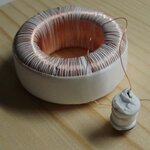neazoi
Advanced Member level 6
Hello, I have a toroidal core biased to a point using a big number of turns.
I need to find the best way to induce an audio signal to the core.
An initial thought was to use a capacitor connected to the audio source and the one end of the DC coil, to block DC back to the audio source and to pass the signal through the DC coil. But the DC coil has many turns and this presents some resistance to the low level audio signal.
Another thought was to wind a separate winding onto the core and insert the audio signal there. This coils will have lower number of turns thus it will not present a significant loss to the signal source, whereas the core will be biased from the separate DC coil.
I would like your comments on these, or any other suitable way.
I need to find the best way to induce an audio signal to the core.
An initial thought was to use a capacitor connected to the audio source and the one end of the DC coil, to block DC back to the audio source and to pass the signal through the DC coil. But the DC coil has many turns and this presents some resistance to the low level audio signal.
Another thought was to wind a separate winding onto the core and insert the audio signal there. This coils will have lower number of turns thus it will not present a significant loss to the signal source, whereas the core will be biased from the separate DC coil.
I would like your comments on these, or any other suitable way.
